The NBA is a sports league driven by its stars. As a team sport, the NBA features the smallest team rosters at 17 players per team and only 13 can be active at any given time. Add or subtract one star player to or from any team and that team’s fortunes are greatly enhanced or reduced as far as winning is concerned.
Basketball is a team game and role-players or a collection of good role-players make a team successful. Someone has to do the dirty work like rebounding, boxing out, taking charges, defending, hustling in transition, and making the right passes at the right time.
In recent years, Lou Williams, now the all-time leading bench scorer in NBA history, has won consecutive 6th Man of the Year awards. Players like Jamal Crawford, have been scoring dynamos when substituted into games. There were also players, like Lamar Odom, who did a bit of everything the team needed in a backup role to help a team win.
Two seasons ago, the Toronto Raptors won 59 games in the regular season and their outstanding backcourt duo of Kyle Lowry and DeMar DeRozan played less than 35 minutes a game. This was because of the fact the team played three subs 20 plus minutes a game and 6 subs 15 or more.
Explore the NBA Draft 2024 with our free NBA Mock Draft Simulator & be the GM of your favorite NBA team.
A strong bench is a reason the Los Angeles Clippers are expected to feature in the 2020 NBA Finals. Their bench includes the aforementioned Lou Williams and a runner up to his 6th Man Award in 2019, in Montrezl Harrell.
The following is a look at the 5 best benches in NBA history:
#5 1978-79 Washington Bullets: Mitch Kupchak, Greg Ballard, Larry Wright, Charles Johnson, David Corzine
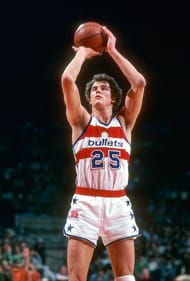
The Washington Wizards were once known as the Washington Bullets and did compete for the NBA Title. The year was 1979 and the Bullets were good. Their team record in the 1978-79 season was 54-28. They faced and lost to the Seattle Supersonic in 5 games in the NBA Finals series. The previous year, the Bullets managed to knock off the same SuperSonics in 7 games in an NBA Finals series that the Supersonics led 3 games to 2.
However, in 1979, the Bullets bench - led by the 14.6 ppg average of Mitch Kupchak - provided the squad with just over 52.5 points a game contributing about 45% of the team’s nightly offense of 114.9 ppg. It also helped that Kupchak, Larry Wright, and Charles Johnson each played over 20 minutes a game while Phil Chenier and Greg Ballard also played more than 15 minutes a game. The win-share for the Bullets bench was 17.2.
#4 2005-06 Miami Heat: Alonzo Mourning, Gary Payton, Shandon Anderson, Jason Kapono, Derek Anderson, Antoine Walker
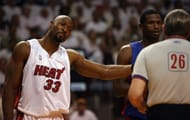
The 2005/06 season was the first of 5 NBA Finals appearances for the Miami Heat since 2000 and the first of three titles they have won. This edition of the Heat’s roster stacked their bench with former stars who were aging and relied heavily on the exploits of Dwyane Wade, their 2003 draft pick, and to a lesser extent Shaquille O’Neal. Wade was averaging 27.2 ppg and Shaq was averaging 20 ppg.
When you add up the production of the bench offensively, the subs added over 40 points a game to the tally of the starters. Antoine Walker, the former Boston Celtics star, led this Miami bench with 12.2 ppg while 3-point specialist Jason Kapono was deadly accurate from long range at 39.6%.
Alonzo Mourning averaged 7.8 ppg but was blocking 2.7 shots and along with Antoine Walker combined for over 10 rebounds per game. The combined win share of the 2006 Miami Heat bench was 18.6.
#3 2002-03 San Antonio Spurs: Malik Rose, Manu Ginobili, Steve Smith, Steve Kerr, Speedy Claxton, Kevin Willis, Danny Ferry
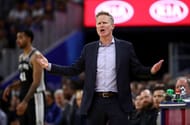
The San Antonio Spurs have won 4 NBA titles since the turn of the new millennium and 2003 was a championship year for the Spurs. A strong starting lineup was supported by a solid rotation of substitutes led by Steve Smith, Manu Ginobili, and Malik Rose. The three averaged over 20 minutes of playing time a game and provided the team with 24 points a game combined.
Steve Kerr, now the Golden State Warriors head coach, was a three-point specialist making 39.5% of his three-pointers for the Spurs then. This was also the last season of the great David Robinson (known as The Admiral), and Kevin Willis was a solid backup at center. These backups combined for a win share in 2002-03 of 18.9.
#2 2006-07 San Antonio Spurs: Brent Barry, Fabricio Oberto, Robert Horry, Francisco Elson, Matt Bonner, Jacque Vaughn, and Beno Udrih
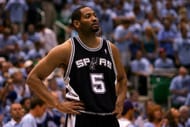
The San Antonio Spurs, since the drafting of Tim Duncan in 1997, have always been in the discussion of the best team or potential champion each year. The organization has always found solid players who play pivotal roles in the success of the team. The 2006-07 Spurs were no exception winning the NBA title that year. With Duncan, Ginobli, and Parker playing starring roles, the Spurs backups provided consistent shooting, rebounding and defense.
Guard Brent Barry shot 47.5% from the field and over 44% from the 3-point arc. Both backup center Francisco Elson and power forward Fabricio Oberto averaged just under 5 rpg each. It is also remarkable to note that, “Big Shot Bob”, Robert Horry also played for this championship team. Horry was known for making clutch plays happen out of nowhere. This bench crew compiled a combined win share of 21.4.
#1 1988-89 Detroit Pistons: Rick Mahorn, John Salley, Dennis Rodman, Vinnie Johnson, James Edwards
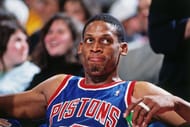
The “Bad Boys” of Detroit dominated the NBA’s Eastern Conference for three years in the late 1980s. They appeared in three straight NBA Finals and won two consecutive in 1989 and 1990. Their acquisition of Mark Aguirre, formerly of the Dallas Mavericks, mid-season in 1989 added just enough finesse and scoring to a physical lineup that hammered and battered their opponents into submission most games.
With Aguirre in the starting lineup, Rick Mahorn’s power was more effective off the bench and allowed him to go hard at his opponents. In only 24 minutes a game, he did not need to worry about foul trouble. A young John Salley (The Spider) and Dennis Rodman (The Worm) were defensive stoppers combining for over 14 rpg between them. They also combined for 2 blocked shots a game, as well.
James Edwards was an interior/post scorer averaging 7.3 ppg that season. Vinnie Johnson was known as the “Microwave”. He could make shots anytime anywhere and provided the Pistons with 13.8 ppg in the 1888/89 season. What defined the “Bad Boys” of Detroit was their aggressive physical defensive play that held opponents to 100.8ppg for 2nd best in the NBA during the 1988/89 season. This edition of the Pistons’ bench had a win share of 24.9.
Spurs Fan? Check out the latest San Antonio Spurs depth chart, schedule, and roster updates all in one place.
